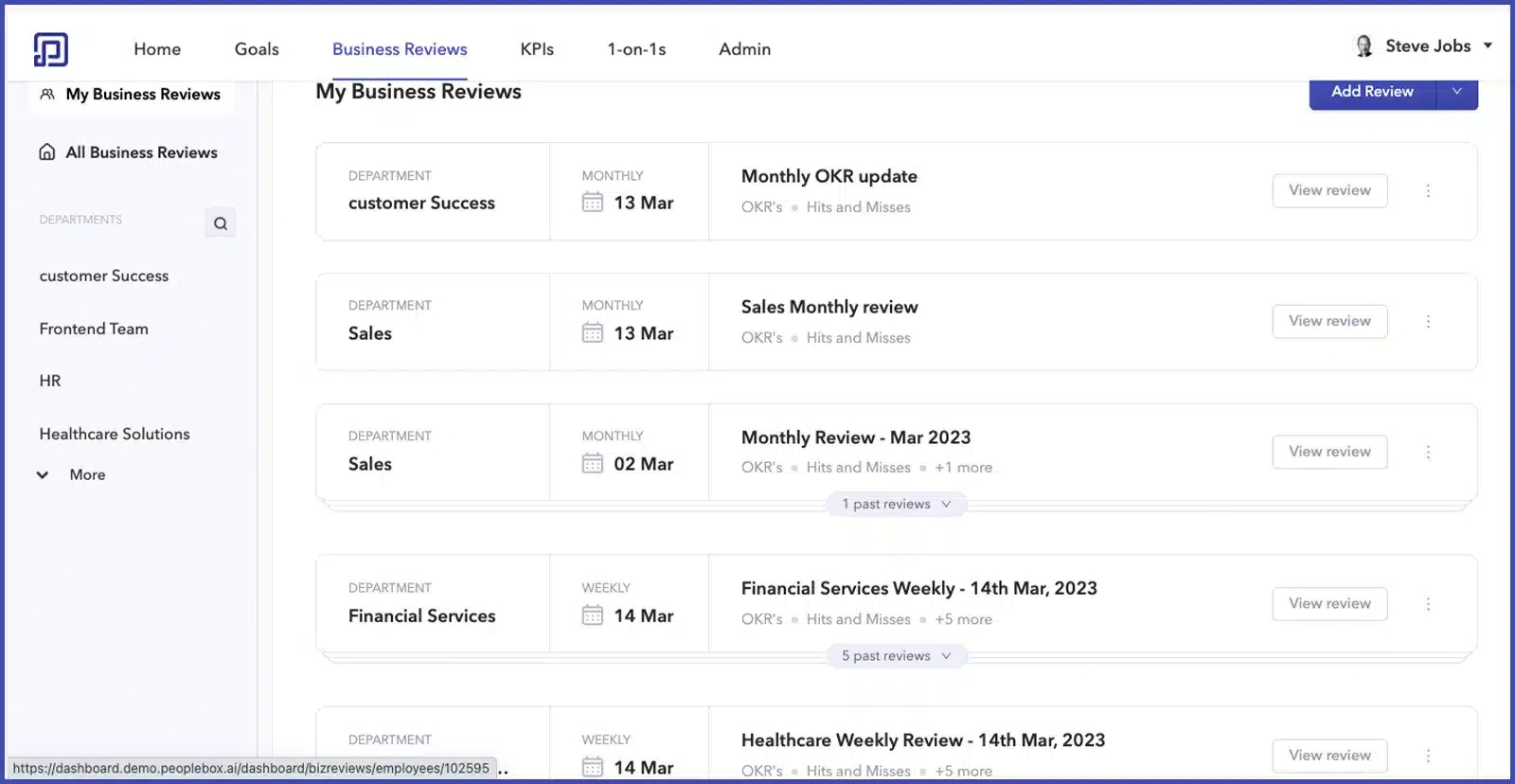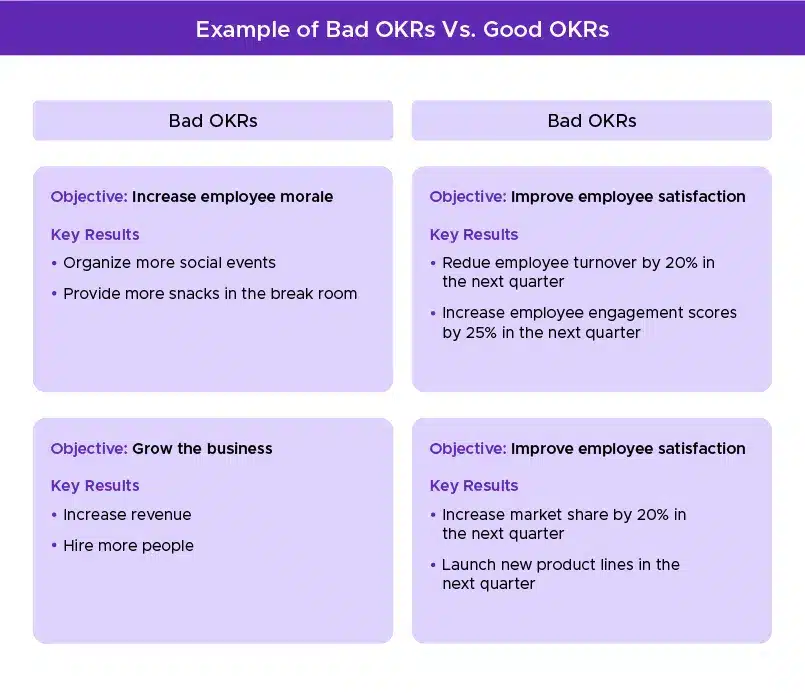In today’s hypercompetitive business landscape, achieving goals and staying aligned as a team is crucial for success. And that’s where OKRs come in. The framework provides a powerful tool for setting and tracking goals, aligning teams, and improving team performance.
But, merely setting OKRs is not enough. Regular reviews are essential to ensure that teams stay on track, make necessary adjustments, and maintain momentum toward their objectives.
However, in a world where people are increasingly wary of multiple meetings, it’s essential to make these reviews productive and efficient. Meetings that are too long, too frequent, or lack focus can be counterproductive and lead to a lack of engagement and morale among team members. In fact, a Harvard Business Review study found that 71% of the participants said meetings are unproductive and inefficient. Therefore, it’s crucial to ensure that OKR reviews are structured, effective, and achieve their intended goals.
This blog post will provide you with all the information you need to conduct effective OKR reviews throughout the year, while maximizing the value of each meeting. Read along!

The Impact of Regular OKR Reviews on Strategy Execution & Organisational Growth
Regular OKR reviews are not just a box-ticking exercise but a powerful tool that can revolutionize how teams and organizations approach strategy execution, goal-setting and employee performance management. These reviews offer numerous benefits, including:
Staying Focused on Goals: Regular OKR reviews enable teams to stay focused on their goals, even in the face of distractions and unforeseen challenges. By continuously tracking progress, teams can ensure they remain aligned with their objectives and make any necessary adjustments to their strategies.
Identifying Obstacles: Through regular reviews, teams can quickly identify any roadblocks or obstacles that may be impeding their progress toward their goals. This early identification allows teams to take corrective action promptly and minimize any negative impact on their performance.
Encouraging Continuous Improvement: Regular OKR reviews foster a culture of continuous improvement within the organization by providing teams with a platform to assess their performance regularly. By identifying areas for improvement, teams can make the necessary changes to enhance their performance and achieve their objectives.
Promoting Collaboration: Regular OKR reviews provide a platform for teams to collaborate and share their progress, challenges, and solutions. This helps to maintain alignment and ensures that all team members are working towards a common goal.
Boosting Accountability: Through regular OKR reviews, team members become more accountable for their performance and progress toward their goals. This accountability helps to promote a sense of ownership and responsibility, leading to higher levels of motivation and engagement.
To fully realize the benefits of regular OKR reviews, it’s important to understand the different types of reviews and how they can be used to achieve specific objectives. There are three types of OKR reviews: weekly check-ins, monthly/quarterly reviews, and Annual reviews. In the following section, we will briefly explore each type of review and discuss the benefits that they provide.
Types of OKR Reviews
Regularly conducting OKR reviews at varying intervals is crucial to obtain the advantages mentioned earlier. These reviews come in three types, namely weekly check-ins, quarterly reviews, and Annual reviews, each serving a distinct purpose and offering varying levels of detail.
1. Weekly check-Ins
Weekly check-ins provide an excellent opportunity for teams to stay aligned and focused on short-term goals. These informal and quick meetings are perfect for discussing progress toward objectives, identifying roadblocks, and collaborating to find solutions. With a duration of 60 minutes or less, weekly check-ins allow team members to stay connected and engaged without sacrificing productivity.
2. Quarterly reviews
Quarterly check-ins are more formal than weekly check-ins and provide an opportunity to assess progress toward longer-term goals. These reviews typically last 60-90 minutes and involve a comprehensive review of progress toward objectives, including key results and metrics. Teams can assess whether they’re on track to meet their goals and identify any areas where they need to adjust. They can also celebrate wins and successes and share best practices that helped them achieve their objectives.
3. Yearly reviews
Yearly check-ins are the most comprehensive type of OKR review and involve a detailed review of overall performance and alignment. During yearly check-ins, teams can review their progress over the past year, assess whether they’ve met their objectives, and identify areas for improvement. These reviews typically involve a more in-depth analysis of performance metrics and can last several hours, depending on the size and complexity of the organization. Year-end reviews also offer an opportunity to set new objectives for the coming year and ensure alignment with the company’s overall vision and mission.
Now that we’ve covered the types of reviews, let’s explore the strategies that can help you excel in those reviews. To ensure maximum effectiveness throughout the process, we have categorized these strategies into three sections: Preparing for the Review, Conducting the Review, and Maintaining Momentum.
Preparing for the Review
1. Setting the stage for a successful review
The first step in preparing for an OKR review is setting clear expectations and timelines for the review process. This involves communicating with team members to align everyone’s goals and ensure everyone understands the review process. It is essential to establish a timeline and communicate it clearly with all team members to prevent confusion and ensure that everyone is aware of deadlines.
With Peoplebox, you can set multiple check-ins throughout the OKR cycle within the platform.

ProTip: Keep your weekly check-ins concise, lasting only 45-60 minutes. Reserve longer durations, such as 90 mins for quarterly reviews, and allocate a substantial amount of time, around 4-5 hours, for yearly reviews.
2. Gathering and analyzing data on OKR progress
Making the OKR review process data-driven is essential for effectively tracking progress and identifying areas for improvement. It’s important to have a single source of truth for tracking key metrics, as scattered data can lead to confusion and inaccuracies. By creating customizable dashboards that provide a visual representation of progress towards goals, team members can easily identify areas where progress is lagging and take corrective action.
Additionally, tracking performance metrics can help teams stay on track and ensure that they are making progress towards their objectives. Regularly analyzing data through charts, graphs, and spreadsheets can help team members make informed decisions and continuously improve their performance. By making the OKR review process data-driven, teams can stay aligned with their objectives and drive better business results.
ProTip: For weekly reviews, use a tool that automatically collects and consolidates data from different sources, such as an OKR software. For quarterly reviews, set aside enough time to thoroughly review and analyze data, and consider using visualization tools to make the analysis easier. For yearly reviews, plan well in advance and allocate enough time to conduct a comprehensive analysis, identify trends and patterns, and create an actionable plan for the upcoming year.
3. Preparing talking points for the review meeting
Preparation is key to ensure that the OKR review meeting stays on track and remains productive. To prepare for the meeting, team members should develop talking points and questions to address during the review meeting. These questions should be thought-provoking and encourage discussion around the team’s progress towards achieving their objectives. This will help ensure that everyone is prepared, and the conversation remains focused on key objectives.

4. The role of the manager and the employee in the review process
The OKR review process presents a critical opportunity for managers and employees to work together in a collaborative and communicative manner. Effective guidance, feedback, and support from the manager are vital to help team members achieve their objectives. Conversely, employees play a crucial role in communicating their progress, challenges, and concerns to their manager while providing valuable feedback on the process.
Clear understanding of both parties’ roles and responsibilities is essential for a successful review, resulting in increased productivity, better alignment with organizational goals, and improved employee engagement.

Conducting the Review Meeting
1. Best practices for conducting an effective review meeting
We have established how important it is to conduct effective OKR reviews. To ensure that your OKR review meeting is productive and efficient, it’s important to follow best practices. Here are some key best practices to consider:
- Schedule the meeting in advance: Set a date and time and share with all team members.
- Prepare a detailed agenda: Review progress, address roadblocks, and set action items for the next period.
- Ensure team members are prepared: Review progress against individual OKRs and be ready to share updates with the group.
- Encourage collaboration: Foster a positive and collaborative atmosphere, share perspectives and ideas, and be open to feedback.
- Stay focused on objectives: Avoid getting sidetracked by unrelated issues or topics to ensure productivity.
- Follow up after the meeting: Ensure team members are clear on their action items and next steps to continue progress between review meetings.
2. How to provide constructive feedback and address challenges
Effective feedback is key during an OKR review meeting. Focus on behavior, not the person, and provide specific examples to highlight areas for improvement. Encourage open communication and input from team members to create a constructive dialogue. Challenges are opportunities for growth and must be addressed effectively to keep the team on track. Involve the team in creating an action plan, fostering ownership and accountability. Follow up regularly to ensure the challenge is being addressed effectively and make adjustments as needed.
ProTip: If you’re using an OKR software, ensure it has features that enable easy sharing of feedback and updates directly on the platform. This functionality promotes accountability and transparency, allowing all team members to track progress and stay informed about any changes or updates.
3. Recognizing and celebrating successes
Recognizing and celebrating successes is an important part of the review meeting. It boosts morale and motivates team members to continue performing at their best. Take time to acknowledge team members’ efforts, successes, and achievements, and celebrate milestones achieved during the review period. Create a positive and encouraging atmosphere to keep team members motivated and engaged.
ProTip: In weekly reviews, acknowledge and celebrate small wins achieved by team members, which will keep them motivated. In quarterly reviews, highlight significant accomplishments achieved by the team during the quarter. For yearly reviews, take the time to recognize major milestones achieved by the team during the year and celebrate them in a meaningful way.
4. Setting goals and action items for the upcoming period
The OKR review process provides an opportunity to reflect on what went wrong and what needs to be improved. By analyzing past performance, teams can set better goals for the upcoming period that are more relevant, achievable, and tailored to individual strengths. A well-defined action plan can help ensure that these goals are successfully achieved.
Here are some quick examples of a good OKR vs a bad one.

5. Tips for effective communication during the review meeting
Effective communication is essential for a successful review meeting because it ensures that all participants are on the same page regarding the objectives, progress, and areas for improvement. The review meeting is an opportunity for team members to discuss their progress and performance, and effective communication is critical in facilitating an open and productive dialogue.
Here are some best practices to ensure effective communication during OKR reviews:
- Practice active listening: Listening is the most critical aspect of communication. To ensure effective communication, active listening is necessary. It shows your team members that you respect their opinions and are willing to work with them.
- Asking open-ended questions: Open-ended questions encourage dialogue and help to gain a deeper understanding of the team member’s thought process. It also shows that you are genuinely interested in their perspective.
- Encouraging dialogue and collaboration: Encouraging dialogue and collaboration during the review meeting can help you gain more insight into the team member’s performance, provide feedback and help them align their goals with that of the company.
Following Up and Maintaining Momentum
1. How to ensure progress continues after the review meeting
In order to ensure that progress continues after the review meeting, it is essential to take actionable steps to keep the momentum going. This can be achieved by setting new targets, assigning responsibilities, and fostering a culture of accountability.
One way to maintain momentum is to set new targets immediately after the review meeting. This ensures that team members remain focused on their goals and continue to work towards them. Additionally, assigning responsibilities and creating a clear plan of action can help keep team members accountable and motivated.
Fostering a culture of accountability is also crucial. Encouraging team members to take ownership of their goals and holding them accountable for their progress can help maintain momentum and drive results.
For example, Peoplebox lets you assign each key result to an individual right in the platform. That way, everyone knows who is accountable for a particular KR.
2. Tracking progress and updating OKRs as needed
Tracking progress and updating OKRs as needed is critical to ensure that the team stays aligned with its objectives. This involves measuring and analyzing progress towards goals regularly and making adjustments as necessary.
One way to track progress is through the use of customizable dashboards, which can provide a visual representation of progress towards goals. This can help identify areas where progress is lagging and provide an opportunity to take corrective action.
Updating OKRs as needed is also important to ensure that they remain relevant and achievable. This can involve adjusting the scope or timeline of the OKR or modifying the key results to better align with the overall objective.
Simplifying the OKR Review Process with Peoplebox
Running successful OKR reviews on a regular basis can be overwhelming, but the good news is that there are tools and processes available to make the process much easier.
Peoplebox is one such tool that can help you streamline your OKR reviews and make them a breeze. Our advanced platform is designed to help you manage your OKRs efficiently and effectively. With a customizable and interactive review dashboard, automatic progress updates, real-time progress tracking, and performance analytics, Peoplebox can revolutionize the way you manage your goals.
By using Peoplebox, you can simplify your OKR review process, improve team alignment, and ultimately drive better business results.
See our product in action. Talk to us today.






